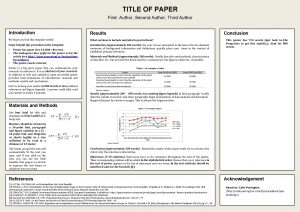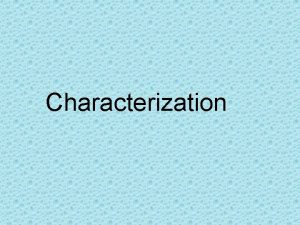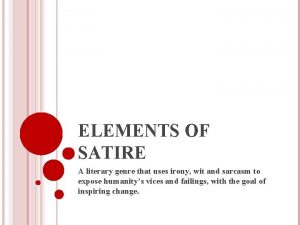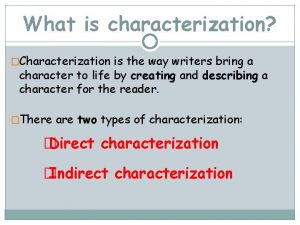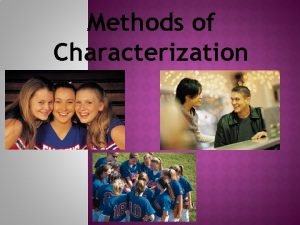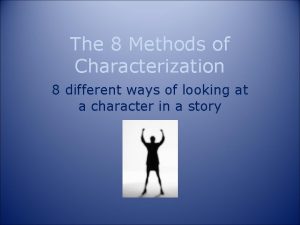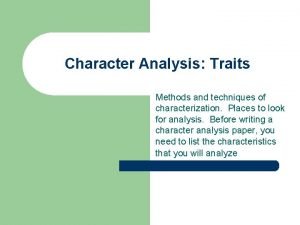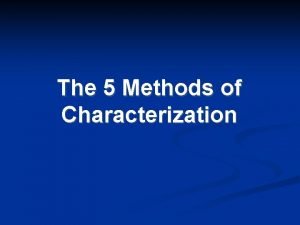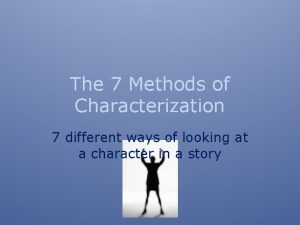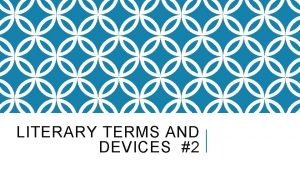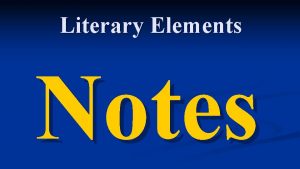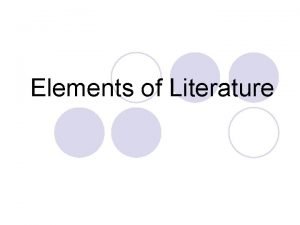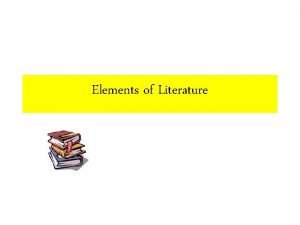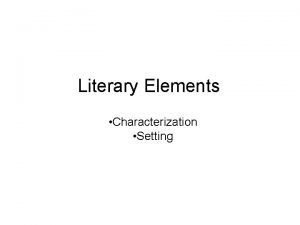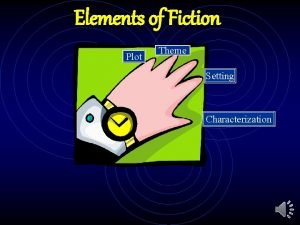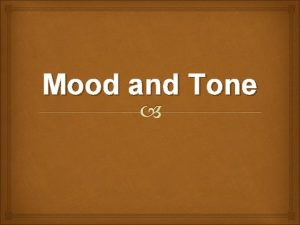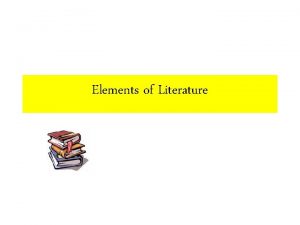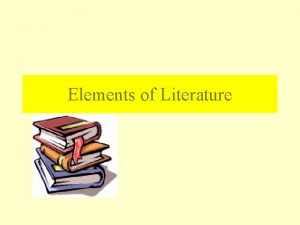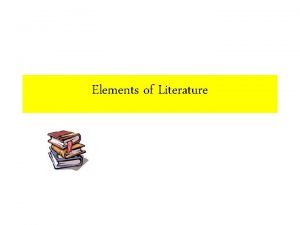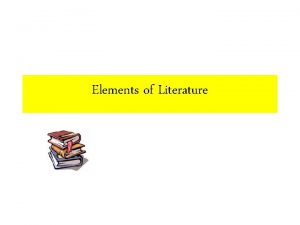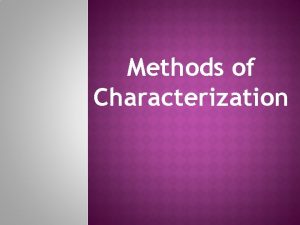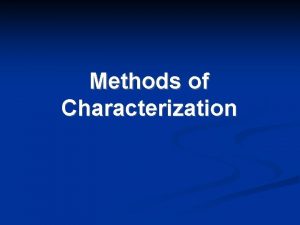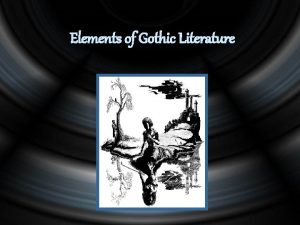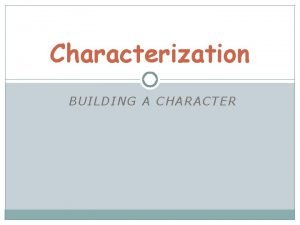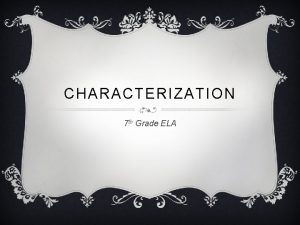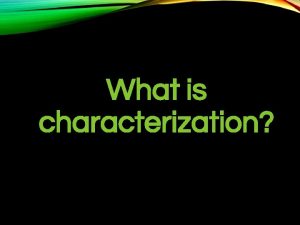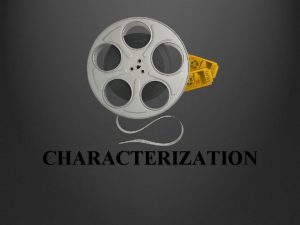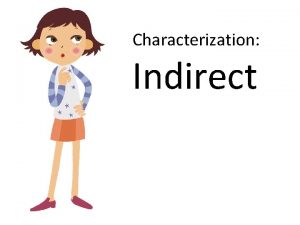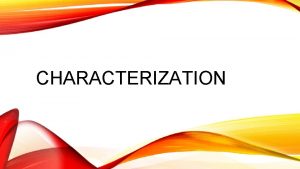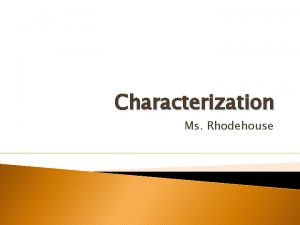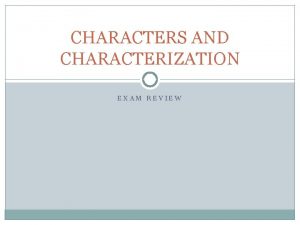Elements of Literature Characterization The methods an author




























- Slides: 28

Elements of Literature

Characterization The methods an author uses to acquaint a reader with the characters in a work. He or she might… • describe the character’s physical traits and personality • report the character’s speech and behavior • give opinions and the reactions of other characters toward this individual • reveal the character by describing the character’s feelings and thoughts.

Protagonist • A protagonist is considered to be the main character or lead figure in a novel, play, story, or poem. It may also be referred to as the "hero" of a work. The action usually revolves around the protagonist.

Antagonist • The character in a work of literature who opposes the main character.

Types of Characters • Dynamic Character- a character who develops or changes as a result of the actions of the plot. • Static Character – a character who remains basically unchanged throughout a story.

Conflict • A struggle between opposing forces; conflicts can be external (outside forces) or internal (within a characters mind).

External Conflict (Struggle with an outside force. ) • • Man-vs-man Man-vs-nature Man-vs-animal Man-vs-society

Internal Conflict (Takes place in the character’s mind. ) • Man-vs-Self

Setting • The time and the place of the story or novel. • A story can be set in a realistic or imaginary place and can occur in the past, present, or future.

• Point of View • • • The perspective from which the story is told. First Person- ‘I’: The narrator of the story is a character in the story that is telling the story from his own personal view. The story is told from the point of view of ‘I. ’ Second Person: When the author speaks directly to the reader. Third Person Limited- ‘He, she it”: Told like a reporter reporting the news or by an outsider who can see into the mind of one of the characters. This point of view can also be told by an outsider who can see into the minds of many characters (all knowing).

Plot • What happens 1 st, 2 nd, 3 rd, and so on. • The plot centers on at least one major problem called a conflict.

Five Main Parts of the Plot • Exposition or beginning: setting and introduction of main Climax characters • Rising Action: Initial incident, suspense, shows conflict or struggle, complications, details, Rising Action sequence of events • Climax: Greatest emotional response, turning point of the story • Falling Action: Following the climax, the intensity of the story may subside. The falling action describes the results of the major Exposition events as the action winds down • Resolution: Conflict, crisis, or struggle resolved Falling Action Resolution

Exposition • The opening of a short story or novel. It provides background information that the reader needs to know. • It introduces the characters, describes the setting, and may recap important events before the action of the story.

Rising Action • The chain of events become more complex. The actions and Rising Action feelings of the characters intensify as their problems become more complicated.

Climax • The highest point of interest • Where most action takes place in the store • Involves an important event, decision, or discovery that affects the final outcome.

Falling Action Falling action • Following the climax, the intensity of the story may subside. • The falling action describes the results of the major events as the action winds down.

Resolution • The final part of the story. • It tells how the story ends. All the loose ends are tied up.

Theme • The main idea that the author wishes to The main idea or underlying meaning of a literary work. The theme includes the topic of the writing and a viewpoint or opinion about the topic. For example: • Greed might be the subject. The theme might be, “Greed is destructive and evil. ” • Fighting might be the subject. The theme might be, “Fighting solves nothing. ” • It can be Universal; applying to you and the world.

Mood • A feeling or emotions that a writing or piece of literature stirs in the reader. Factors that Influence Mood: Setting Mood Words: Hopelessness Optimisim Loneliness Details Despair Images Longing Description Enthusiam Happiness Peacefulness Terror

Tone • The approach or attitude that the writer takes toward the subject of the writing. Serene Angry Amusing Hostile Serious Informative Playful Tender Outraged Argumentative

Symbolism • Symbolism is using an object or a thing to stand for or to substitute for another thing. A symbol may be an object a person, and action, or a situation that suggests a meaning beyond its obvious meaning. For example: A heart might be used to symbolize love and affection A knife might be used to symbolize a robber, warrior, or hunter

Irony • Irony is the contrast between what is expected to happen and what actually happens.

Imagery • Imagery can be created by details in the story that appeal to the senses of sight, sound, touch, smell, and taste. Sweet, slow drops of rich orange juice drip from the corners of my mouth and drool off my chin.

Suspense • Suspense is created about the character’s crisis. through the reader’s uncertainty ability to solve a problem, conflict, or

Figurative Language • Figurative language uses comparisons to express a relationship between essentially unlike things Simile Metaphor Hyperbole Personification

Examples of Figurative Language • Simile: Compares two unlike things using like or as: My heart soared like an eagle. • Metaphor: Am implied comparison between two relatively unlike things without using like or as: The jealous girls were a bunch of tigers ready to pounce. • Hyperbole: The comparison by using an exaggerated statement: I’m so tired, I could sleep a hundred years! • Personification: Compares by giving human characteristics to non-human things: The river reached for me with icy fingers.

Flashback • A device that allows the writer to present events that happened before the time of the current narration or the current events in the fiction. Flashback techniques include memories, dreams, stories of the past told by characters, or even authorial sovereignty. • Flashback is useful for exposition, to fill in the reader about a character or place, or about the background to a conflict.

Foreshadowing • An author’s way of hinting or giving clues to the reader of events or developments that might come ater in the story.
 First author second author third author
First author second author third author What is direct and indirect characterization
What is direct and indirect characterization Direct characterization example
Direct characterization example Direct characterization examples
Direct characterization examples Characterization is the way and author
Characterization is the way and author Elements of satire
Elements of satire Characterization is how an author describes
Characterization is how an author describes What is characteriztion
What is characteriztion Characterization is the way an author
Characterization is the way an author Character motivation definition
Character motivation definition 8 methods of characterization
8 methods of characterization Methods of analysis character
Methods of analysis character 5 methods of characterization
5 methods of characterization Methods of characterization
Methods of characterization Protein purification and characterization techniques
Protein purification and characterization techniques Indirect wax pattern
Indirect wax pattern Flat character definition
Flat character definition Direct characterization examples in literature
Direct characterization examples in literature Elements of exposition
Elements of exposition What is direct characterization in literature
What is direct characterization in literature Characterization definition literature
Characterization definition literature Elements of characterization
Elements of characterization Theme plot setting
Theme plot setting Literary elements characterization
Literary elements characterization Suspicious tone
Suspicious tone Hình ảnh bộ gõ cơ thể búng tay
Hình ảnh bộ gõ cơ thể búng tay Slidetodoc
Slidetodoc Bổ thể
Bổ thể Tỉ lệ cơ thể trẻ em
Tỉ lệ cơ thể trẻ em
